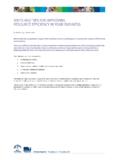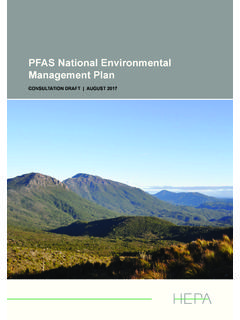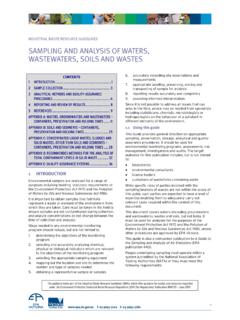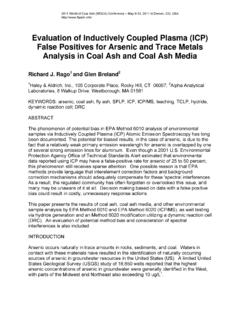Transcription of SAMPLING AND ANALYSIS OF WATERS, WASTEWATERS, …
1 This guidance forms part of the Industrial Waste Resource Guidelines (IWRG), which offer guidance for wastes and resources regulated under the Environment Protection (Industrial Waste Resource) Regulations 2009 (the Regulations). Publication IWRG701 June 2009. 1 INDUSTRIAL WASTE RESOURCE GUIDELINES SAMPLING AND ANALYSIS OF WATERS, WASTEWATERS, SOILS AND WASTES CONTENTS 1 INTRODUCTION ..1 2 SAMPLE COLLECTION ..3 3 ANALYTICAL METHODS AND QUALITY ASSURANCE PROCEDURES ..6 4 REPORTING AND REVIEW OF 5 REFERENCES ..9 APPENDIX A: WATERS, GROUNDWATERS AND WASTEWATERS CONTAINERS, PRESERVATION AND HOLDING TIMES ..11 APPENDIX B: SOILS AND SEDIMENTS CONTAINERS, PRESERVATION AND HOLDING TIMES.
2 25 APPENDIX C: CONCENTRATED LIQUID WASTES, SLUDGES AND SOLID WASTES, OTHER THAN SOILS AND SEDIMENTS CONTAINERS, PRESERVATION AND HOLDING TIMES ..28 APPENDIX D: RECOMMENDED METHODS FOR THE ANALYSIS OF TOTAL CONTAMINANT LEVELS IN SOLID WASTE ..32 APPENDIX E: QUALITY ASSURANCE SYSTEMS ..36 1 INTRODUCTION Environmental samples are analysed for a range of purposes including meeting statutory requirements of the Environment Protection Act 1970 and the Pollution of Waters by Oils and Noxious Substances Act 1986. It is important to obtain samples that faithfully represent a waste or element of the environment from which they are taken. Care must be taken in the field to ensure samples are not contaminated during collection, and analyte concentrations do not change between the time of collection and ANALYSIS .
3 Steps needed in any environmental monitoring program should include, but are not limited to: 1. determining the objectives of the monitoring program 2. selecting and accurately analysing chemical , physical or biological indicators which are relevant to the objectives of the monitoring program 3. selecting the appropriate SAMPLING equipment 4. mapping out the location and site to determine the number and type of samples needed 5. obtaining a representative sample or samples 6. accurately recording site observations and measurements 7. appropriate labelling, preserving, storing and transporting of sample for ANALYSIS 8. reporting results accurately and completely 9. providing informed interpretation.
4 Since it is not possible to address all issues that can arise in the field, advice may be needed from specialists including statisticians, chemists, microbiologists or hydrogeologists on the behaviour of a pollutant in different elements of the environment. Using this guide This Guide provides general direction on appropriate SAMPLING , preservation, storage, analytical and quality assurance procedures. It should be used for environmental monitoring programs, assessments, risk management, investigations and audits. The target audience for this publication includes, but is not limited to: laboratories environmental consultants licence holders custodians of waste/sites containing waste.
5 While specific roles of parties involved with the SAMPLING / ANALYSIS of wastes are not within the scope of this guide, such parties are expected to have a level of expertise enabling them to adequately carry out relevant tasks required within the context of this document. This document covers waters (including groundwaters and wastewaters), wastes and soils, but not biota. It must be used for analyses for the purposes of the Environment Protection Act 1970 and the Pollution of Waters by Oils and Noxious Substances Act 1986, unless other procedures are approved by EPA Victoria. This guide is also a companion publication to A Guide to the SAMPLING and ANALYSIS of Air Emissions (EPA publication 440).
6 People undertaking SAMPLING must operate within a system accredited by the National Association of Testing Authorities (NATA) or they must meet the following requirements: SAMPLING AND ANALYSIS OF WATERS, WASTEWATERS, SOILS AND WASTES 2 They must have had hands-on training with an appropriate body experienced in SAMPLING . They must have demonstrated knowledge and ability to safely take, preserve, store and transport samples within the requirements of this document. This includes refresher training, with records kept on the nature and frequency of the training provided. The laboratory conducting the ANALYSIS must provide appropriately prepared sample containers and preservatives, for the analytes of interest.
7 Satisfactory SAMPLING records must be prepared and maintained by samplers, so that laboratory results can be linked back to the date, time and location of the sample collection. Planning a SAMPLING program No single method applies to all monitoring and assessment needs. The design of a successful SAMPLING strategy depends on determining the objectives and the hypothesis to be tested. Wherever possible, an objective should be expressed as a statistically testable hypothesis. Any SAMPLING program needs to be based on a good understanding of the spatial and temporal distribution of the indicator and its physico- chemical behaviour in the environmental element being investigated.
8 Statistical methods should be employed to ensure that the selected SAMPLING locations and timing represent both indicator behaviour and the discharge or study area, so that spatial and temporal attributes are correctly represented. For elements of the environment where a pollutant s distribution is not homogeneous, a good understanding of the factors that affect this distribution will assist in developing a statistical basis for obtaining representative samples. For example, the spatial distribution of a pollutant could be affected by spot spills onto soils. In the case of water bodies, understanding the vertical stratification in large water bodies and the effects of mixing in flowing streams, may be important in characterising them.
9 Temporal attributes of an environment indicating variations in time should be accurately characterised by the selected SAMPLING strategy. Examples of temporal variations include changes in industrial processes over a periodic cycle that affect effluent quality and storm events where short-term peak stormwater pollutant concentrations enter natural waterways. Composite SAMPLING (collected samples are mixed to give an average concentration) is also a useful screening tool that can represent study areas or flows that are heterogeneous in space or time. This may be unsuitable for detecting hot spots because polluted single samples may become diluted, resulting in the hot spot being undetected.
10 Some pollutants, oil which floats on still water, do not mix with the surrounding matrix. If the objective is to quantify its concentration, it may be difficult taking a representative volume of the water body. In such cases, the impact may be governed by the area covered, which needs to be estimated in the field. However, if the objective is to characterise the nature of the oil, then skimming the oil off the water surface will be sufficient. When SAMPLING wastes stored in a drum or other storage container, it should not be assumed that the contents of the drum are homogeneous; the SAMPLING strategy should account for the nature and quantities of any distinct liquid or solid layers in the container.

















